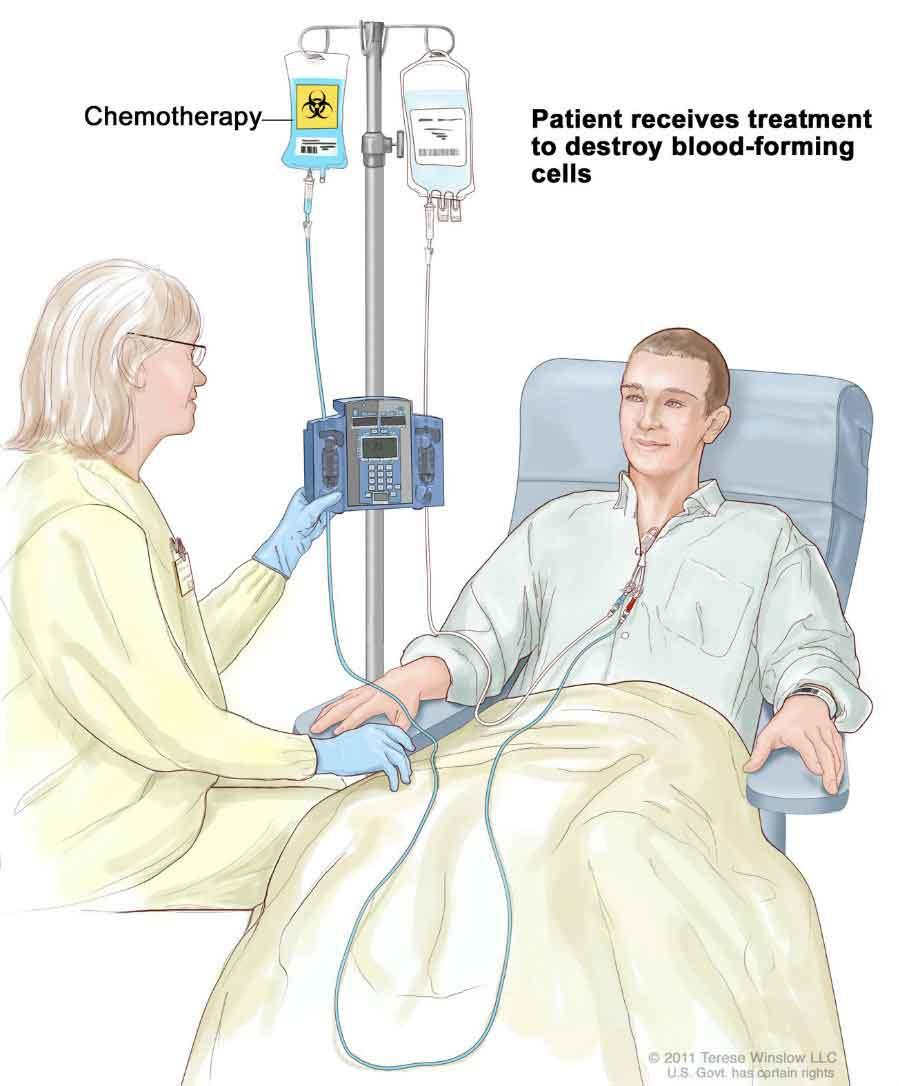Approach May Allow for Stem Cell Transplant without Radiation, Chemotherapy
, by NCI Staff
In a proof-of-concept study in mice, researchers from the Stanford University School of Medicine successfully performed hematopoietic (blood) stem cell (HSC) transplants (also called bone marrow transplants) without first using radiation or chemotherapy.
Instead of these toxic conditioning regimens, which are normally used to clear existing stem cells in the bone marrow before transplantation, the researchers used two biological agents that selectively eliminated HSCs in the host mice but left other tissues and organs undamaged.
If the technique can be translated to humans, “hematopoietic cell therapy could potentially be expanded to those who currently cannot safely tolerate the preparative therapy for bone marrow transplant,” including frail, elderly patients, said Richard Little, M.D., of NCI's Cancer Therapy Evaluation Program, who was not involved in the study.
The results were published August 10 in Science Translational Medicine.
Clearing the Way for New Stem Cells
Stem cell transplantation can be a lifesaving treatment for patients with some types of cancer, primarily blood cancers like leukemia and lymphoma.
However, the procedure is sometimes grueling for patients and potentially dangerous. Prior to the transplant, patients are often treated with radiation and chemotherapy to kill existing stem cells in the bone marrow so the transplanted donor stem cells have a safe harbor in which to grow and repopulate the body with healthy blood cells (a process called engraftment). And, in the case of HSCs from a genetically similar but not identical donor (an allogeneic transplant), these conditioning treatments help to suppress an immune response against the transplanted cells.
But the conditioning regimen can damage a patient’s healthy cells and tissues as well as their HSCs, resulting in side effects, including infections, respiratory problems, and organ damage that can be fatal in a small percentage of patients.
If the preparation for transplantation could be made less toxic to healthy cells, explained Judith Shizuru, M.D., Ph.D., the study’s senior author, the procedure could potentially be used not just for cancer but for other indications. These include treating diseases caused by malfunctioning blood and immune cells, including autoimmune diseases and blood disorders marked by abnormal hemoglobin (such as sickle cell anemia or thalassemia), as well as improving gene therapy and organ transplantation.
Previous research, by the Stanford team and others, has shown that biological agents that target c-kit, a protein that HSCs use for many of their normal cellular functions, can deplete HSCs in mice lacking a functioning immune system. However, in earlier studies, targeting this single protein did not deplete the HSCs in mice with a functioning immune system.
So the Stanford researchers tested whether targeting a second protein, called CD47, in addition to c-kit could eliminate HSCs in mice with a healthy immune system. CD47 serves as a “marker of self” for HSCs and some other types of cells, telling the immune system not to attack them. By blocking CD47 with a specially designed molecule, the researchers hoped to make HSCs vulnerable to treatment with an agent targeting c-kit.
The combination worked. In mice with healthy immune systems that were treated with both agents, the researchers saw a 10,000-fold reduction in the targeted HSCs, to the point where “we could no longer measure them,” said the study’s lead author, Akanksha Chhabra, Ph.D.
In further experiments, mice with healthy immune systems were treated with both agents or with a c-kit-targeting agent alone and then underwent a modified form of an autologous stem cell transplant. The mice that received both agents showed 100 times more engraftment of the donor stem cells in their bone marrow than mice treated with the anti-c-kit agent alone, and healthy cells derived from the transplanted HSCs were found in the blood, spleen, bone marrow, and thymus.
The researchers also tested in mice whether the general approach would work in a type of allogeneic transplant. They treated mice with the two-agent conditioning regimen and with additional biological agents to deplete immune cells (T cells) to prevent the immune system from attacking the transplanted cells. The transplant was successful, with the donor cells successfully establishing themselves in the recipient’s bone marrow and producing healthy blood and immune cells.
Toward Human Trials
Agents that target c-kit and CD47 have already been tested in human studies in healthy volunteers and cancer patients, respectively, explained Dr. Shizuru, and no major side effect have been observed. The team has also recently begun enrolling patients in a clinical trial using an agent that targets c-kit for children with severe combined immunodeficiency disease. In mice, added Dr. Chhabra, researchers have seen some graying of the fur and drops in sperm counts due to the c-kit antibody, but “when the treatment stopped, the sperm counts did go [back] up,” she said. The current study did not look at long-term effects on fertility.
The next step is to test the drug combination as a conditioning regimen for HSC transplantation in nonhuman primates, said Dr. Shizuru. Since the drugs have already begun human safety studies as single agents, she thinks early human trials of the combination for HSC transplantation could begin in the next 3 to 5 years.
“The goal of this study, and what we’re hoping we’ve shown, is that we’re going to change the way that blood and marrow transplants will be done in the near future," Dr. Shizuru said. "We foresee that transplants will be safer to perform and that many more patients can be treated with this potentially curative cellular therapy.”
